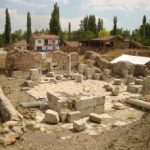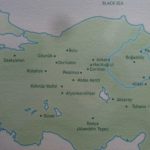There are literally thousands of mosques in Turkey – there are said to be more than 3,000 of them in İstanbul alone and more than 82,000 in the whole country. The ones that tend to scoop all the publicity and the large imperial mosques of İstanbul, many of them designed by the great Mimar Sinan during the reign of Süleyman the Magnificent although the city also has some fine late 19th-century mosques designed by the Balyan family of architects too. There are also a few early Ottoman mosques on a smaller, simpler scale, although the best place to admire early Ottoman mosques has to be Bursa, the capital of the first Ottoman sultans.
Around the country there are many smaller mosques which don’t appear particularly interesting externally yet turn out to have beautiful interiors, either lavishly painted in a folk arty style or elaborately carved in wood. Around Denizli there is a particularly interesting collection of small mosques with painted interiors, while around Rize there are some fine wooden interiors. A more scattered group of what are colloquially known as ‘forest mosques” (officially “wooden hypostyle mosques”) actually became a world heritage site in 2023. They are the Ulu Camis in Afyon and Sivrihisar, the Eşrefoğlu Cami in Beyşehir, the Mahmud Bey Cami in Daday and the Alaattin Cami in Ankara.
In the south-east of the country mosque architecture is more varied than in the west. Gaziantep and particularly Diyarbakır, for example, feature mosques with black-and-white striped walls, while those of Şanlıurfa are often of honey-coloured stones. Between Adana and Antakya there are lots of mosques whose minarets are topped off with witch’s hats.
The sad truth is that most modern mosques are at best cut-down concrete versions of the old Sinan model. Only in İstanbul are there a handful of truly innovative mosques such as the Şakirin Cami in Karacaahmet, the İhlayiyat Cami in Bağlarbaşı, the Sancaklar Cami in Beylikdüzü or even the tiny Şüca Mehmet Çavüs Cami in Cerrahpaşa. The huge new Çamlıca Cami is internally gorgeous but externally disappointing.
The vocabulary of a mosque
Hünkar mahfili – private box for the sultan, often accessible via private entrance
Kürsü – seat from which imam reads Koran
Mimber – pulpit, usually at top of a flight of steps
Mihrab – niche in the wall facing towards Mecca
Minaret – tower from which call to prayer is made
Müezzin mahfili – private pew where muezzin sings responses to imam’s prayers
Şadırvan – fountain for communal ablutions
Şerefe – balcony of minaret
Son cemaat yeri – vestibule/portico leading into mosque
The mosque complex (külliye)
In the past the great imperial mosques sat at the heart of extensive külliyes (complexes) offering a variety of social services including hamams, libraries, soup kitchens and schools.
The vocabulary of a mosque complex :
Bimarhane – mental hospital
Çeşme – fountain
Dar-ül kura – Koran school
Darüsşifa – hospital
Dergah – dervish lodge
Dershane – lecture hall
Hamam – Turkish bath
Hastane – hospital
Hücre – student’s cell (room)
İmaret – soup kitchen
Kervansaray – inn where traders and their animals could stay
Medrese – religious seminary
Şadırvan – ablutions fountain
(Sibyan) Mektep – primary school
Tabhane – hospice for traveling dervishes
Tekke – dervish lodge
Türbe – tomb

